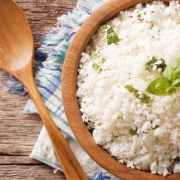Small Intestinal Bacterial Overgrowth (SIBO) Can Mimic Gluten Exposure
This is a common scenario among my patients with celiac disease and non-celiac gluten sensitivity. Bottom line: Don’t assume it’s normal to be feeling unwell. I hear many patients say, “I just assumed everyone had diarrhea twice a day and I got used to living with it.” If you are still experiencing symptoms, talk to your doctor and ask for testing. You deserve to be in excellent health.
Melinda Dennis, MS, RDN, is a registered dietitian specializing in celiac disease and gluten-related disorders, author, nationally acclaimed speaker, and the Nutrition Coordinator of the Celiac Center at Beth Israel Deaconess Medical Center in Boston. She offers gluten-free consulting through her private firm, Delete the Wheat, LLC.
Small intestinal bacterial overgrowth (SIBO)
People naturally have hundreds and hundreds of different bacterial species in their colon and much fewer in their small intestine. In SIBO, there are large numbers of bacteria or the wrong type of bacteria in the small intestine. There are many medical conditions and treatments that can predispose someone to SIBO, including celiac disease and small bowel dysmotility. People with celiac disease may have a higher incidence of SIBO.
SIBO leads to symptoms that mimic gluten exposure such as severe abdominal bloating (a major complaint), abdominal distension (visible protrusion of the abdomen), increased gas, diarrhea and/or constipation. Other symptoms can include nausea, weight loss, and early satiety (feeling full after eating a small amount of food), to name a few. In addition, these bacteria compete for nutrients such as Vitamin B12 and other B vitamins, vitamin A, D, and E, iron, fat, protein and carbohydrates (starches).
There is no single validated testing method for SIBO; currently the ones most often in use are the lactulose or glucose breath tests which measure a person’s output of hydrogen and methane gas to diagnose SIBO. Treatments vary greatly among practitioners regarding the use or avoidance of antibiotics (traditional or herbal). Generally accepted are recommendations to monitor and treat nutritional deficiencies and to consume easily digested foods that have modest (not high) amounts of fiber. Moderate, regular exercise and adequate fluid intake can help to normalize bowel patterns. Spacing meals ~4 hours apart (if possible) allows the body’s migrating motor complex to cleanse the small intestine with intestinal juices, washing away bacteria. This meal spacing time frame varies in the literature and also by a patient’s medical status. Use or avoidance of probiotics varies widely among clinicians.
At this time, there are no research studies validating a specific diet therapy for SIBO. Several diet therapies have been suggested and are in use – most of them with the goal of reducing sugars that the bacteria favor. The low FODMAP diet and the elemental diet (short-term use of a predigested, easily absorbed nutritional oral supplement) seem to be the most commonly used ones in clinical practice. The priority is on a nutritionally balanced diet that can be achieved long- term. Consultation with a skilled dietitian is important to ensure nutritional balance.
SIBO is not a symptom; it is a diagnosis. The finding of SIBO may suggest an underlying problem. The goal is to identify and treat the cause. This brief description only scratches the surface of SIBO.
For information on conditions that increase the risk of SIBO and a variety of clinical testing approaches and treatment options that appear in the literature, please visit these resources/references:
https://blog.katescarlata.com/2014/01/22/small-intestinal-bacterial-overgrowth (Kate Scarlata MS, RDN)
https://theceliacmd.com/2013/11/november-2013-sibo-gluten-ibs-connection (Amy Burkhart MD, RDN)
https://drmarkpimentel.com/index.htm (Dr. Mark Pimentel)
https://siboinfo.com (Dr. Allison Siebecker)
Tursi A, Brandimarte G, Giorgetti G. High prevalence of small intestinal bacterial overgrowth in celiac patients with persistence of gastrointestinal symptoms after gluten withdrawal. Am J Gastroenterol. 2003 Apr;98(4):839-43.
https://www.webmd.boots.com/digestive-disorders/small-intestinal-bacteria-sibo (WebMD)
Other Reasons: Less common causes of continued symptoms on the gluten-free diet include, but are not limited to, microscopic colitis, pancreatic enzyme insufficiency, and refractory celiac disease (very uncommon) and can be discussed with your doctor.
____________
For labeling laws in the United States and cross contamination resources, visit: www.glutenfreedietitian.com (Tricia Thompson MS, RDN)
Cross Contamination: Level 3 on celiacnow.org See https://www.bidmc.org/Centers-and-Departments/Departments/Digestive-Disease-Center/Celiac-Center/CeliacNow/NUTRAGFD/NUTRCNSDRGFD/LCTSINT/Level3.aspx
Disclaimer: As Nutrition Coordinator of the Celiac Center at Beth Israel Deaconess Medical Center, I am the lead writer and editor of the website www.celiacnow.org and co-author of the book Real Life with Celiac Disease. Otherwise, I have no business/financial stake in the resources listed in my article above.
Note: The References and Further Reading resources above represent only a portion of the excellent information available on these topics. I recommend PubMed, in particular, for the multiple peer-reviewed journal articles you will find.
Would you like to immerse yourself in nutrition and health at a gluten-free weekend retreat with me in New Hampshire or Santa Barbara, California? We’ll cover all of these nutrition topics and many more in great detail.
Visit: https://www.deletethewheat.com/WellnessRetreatsv2.html or email me for more information: [email protected]
© 2015 Melinda Dennis, MS, RDN/Delete the Wheat. LLC. All rights reserved. https://www.DeleteTheWheat.com
Victoria • Blanshard • Cook-Fairfield • Douglas Street • Fernwood • Fort Street • Government Street • Hillside • Inner Harbour • James Bay • Oak Bay • Quadra • Royal Oak – Broadmead • UVic Or NEARBY in • Brentwood Bay • Colwood • Esquimalt • Langford • Metchosin • Sidney • View Royal On VANCOUVER ISLAND • Campbell River • Chemainus • Cobble Hill • Comox • Coombs • Courtenay • Cowichan Bay • Duncan • Ladysmith • Lake Cowichan • Mill Bay • Nanaimo • Nanoose Bay• Parksville• Qualicum Beach• Port Renfrew• Shawnigan Lake• Sooke • Tofino • Ucluelet On the GULF ISLANDS • Cortes Island • Gabriola Island • Hornby Island • Salt Spring Island














